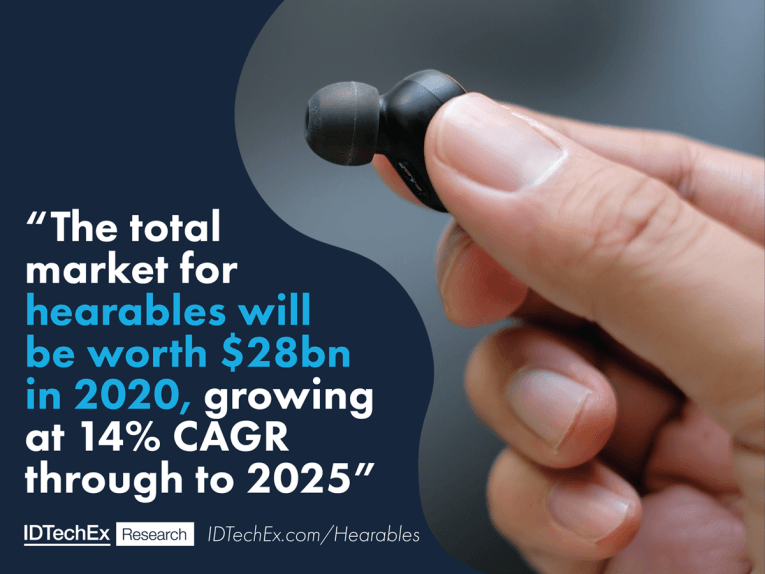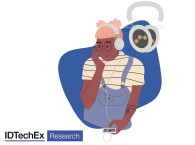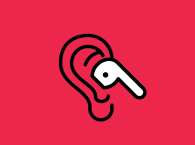
"The first electric hearing aid was created in 1898 and was arguably among the earliest examples of wearable technology. So it is fitting that more than a century later, on- and in-ear technology is once again leading the way – this time as hearables, a sector now poised for substantial growth," says IDTechEx Research.
The new IDTechEx report "Hearables 2020-2030: Technology, Players and Forecasts", provides a detailed and wide-ranging assessment of the current hearables market and relevant developments. Exploring historical data from 2010 to 2019, secondary research covering dozens of firms throughout the value chain and including interviews with more than 20 leading firms in the sector, the study also delivers market forecasts covering 2020 to 2030.
Defining hearables as wireless electronic devices that are worn in, on or around the ear, including connected hearing aids and cochlear implants, IDTechEx focuses on the current market convergence. "The hearables market covers a broad range of technologies, end-users, and sectors at various stages of maturity. For example, the medical hearing aid market has been active for more than a century, but the consumer-facing wireless headphone market did not really gain traction until after 2010."
"Apple’s AirPods, launched in 2016, kickstarted the market, leveraging Apple’s position to becoming the most commercially successful product in the space. This also triggered strong competition in that area as companies battled hard to compete – a battle that persists today.
"In parallel to this commercial rise, another important evolutionary step has been underway, with the inclusion of biometric sensors within hearable devices. This development may prove crucial, for not only is it possible for biometric data to be collected from hearable devices right now, but the potential for biometric hearables is enormous," states IDTechEx.
Hearables 2020-2030: Technology, Players and Forecasts” shows that biometric hearables are set to make a substantial impact on the consumer, over-the-counter (OTC) health, and professional medical markets with a few years, with the market for hearables with biosensors set to reach $5 billion USD by 2030.
The report is the result of over two years of research, including both primary and secondary research from the analyst team at IDTechEx. This has included more than 20 primary interviews with leading players from across the spectrum of products and technologies involved, from large players such as Bose, Starkey, Widex, Oticon and Sonova, through to leading technology players such as Valencell, Well Being Digital and RelaJet, to prominent startups such as Nuheara, Olive Union, and more.
The following section is an extract of the firm's own introduction to the report.

Why Use Hearables With Biosensors?
Wearables with biometric sensors are nothing new – the Pew Research Center found that around one in five Americans now wears a fitness or activity tracker. These are most commonly worn on the wrist, but that market is beginning to see some saturation and so it seems ripe for innovation. In this context, biosensors in or around the ear make perfect sense. Anatomically, the ear is an ideal location for biosensors because it is close to many useful, high-quality biometric signals. For example:
• The ear canal has a shallow, rich capillary bed which makes it suitable for non-invasive monitoring (e.g. heart rate)
• Placing sensors in the ear brings them closer to the body’s core, giving better measurements for core body temperature, etc.
• The ear is close to important signals such as brainwaves, eye movement, speech recognition, and head tracking.
These attributes can not only optimize many of the readings that conventional biometric wearables already track, but also generate new possibilities for consumers and medical professionals alike.
Unobtrusive, comfortable hearables that are comfortable to wear could increase compliance with medical monitoring or study (e.g. drug efficacy trials, ambulatory recording of heart rate, or blood pressure). Hearables can also be used to monitor chronic conditions or general health and to track diet and fitness.
This progress has been supported by recent changes in the regulatory and legal landscape. In 2017, the US Congress passed the Over-the-Counter Hearing Aid Act and created a new class of hearing aid that is regulated by the FDA but can be bought and sold without the involvement of a licensed professional.
Prior to this, the hearing aid market was tightly regulated (as a medical field), which restricted access to the market – consequently, biometric sensors within hearables were largely confined to consumer goods. However, the Act has opened the hearing aid market up to new providers and customers, all of whom will be keen to differentiate their products and brands.
Brave New World?
It is clear from “Hearables 2020-2030: Technology, Players and Forecasts” that the scope for biometric hearables to access and exploit multiple biometrics at once takes their scope beyond that of conventional health and fitness trackers and even hearing aids. An article by Poppy Crum, Chief Scientist at Dolby Laboratories and an adjunct professor at Stanford, explains that the ear is the ideal portal to access data on:
• Heart rate
• Blood oxygen levels
• Movement
• Temperature
• Eye movements
• Skin resistance
• Stress hormone levels
• Brain electrical activity
This means wearables may, in time, be integrated with other technologies including machine learning/AI and cloud computing to discern the physiological, physical, and emotional status of wearers – and trigger actions in response. In this scenario, the hearable ‘knows’ how stressed the wearer is, how best to calm them down (prompting their smart speaker to play a favorite music track, perhaps), which direction they are looking in and how much mental effort they are making. Hearables with voice recognition tech will ‘inform’ the hearable how often the wearer is speaking, in what tone, and even with what emotion.
Indeed, researchers at Cornell University are currently researching the use of hearables to track and translate facial expressions. Such capability may sound futuristic, and not all of it is possible – yet. But a surprising amount of the knowledge and hardware/firmware required is either being developed or has already been integrated into devices.
Where Does This Leave the Hearables Market?
The key message arising from “Hearables 2020–2030: Technology, Players and Forecasts” is that the technological and market landscape for hearables looks promising but faces challenges. Specifically, the report finds that:
• Even though it is still early days for hearables containing biometric sensors, the market forecasts predict that over $5 bn of ear-worn products containing biosensors will be sold by 2030.
• The relative amount of penetration into the total market by volume will be relatively small, but biometric sensor integration is likely to be prominent in higher-value products within each sector, thus potential total revenue is substantial.
• The introduction of biometric sensors to hearable products is likely to be gradual, starting with relatively conventional sensors (e.g. heart rate) but diversifying over time.
Meanwhile, the wider hearables market, including non-biometric products, faces challenges that the report addresses. These include:
• The impact of the 2017 Over-the-Counter Hearing Aid Act and the new product category it creates.
• The likely duration of the current, aggressive, market conditions, and dominance of particular brands.
• The areas of development likely to affect and shape the sector, and those likely to fail.
• Relevant technological advances (e.g. energy sources, upgraded Bluetooth standards).
www.IDTechEx.com/Hearables






